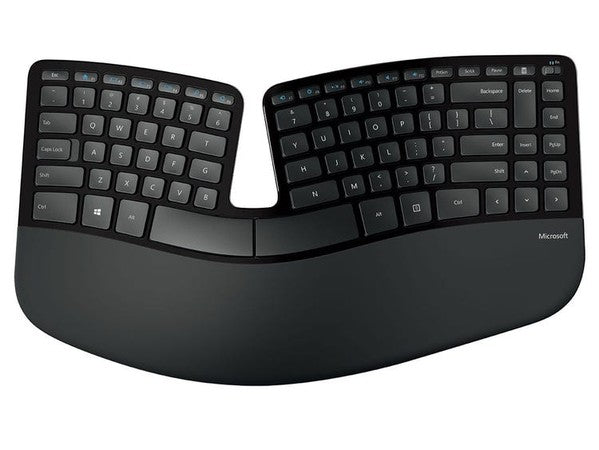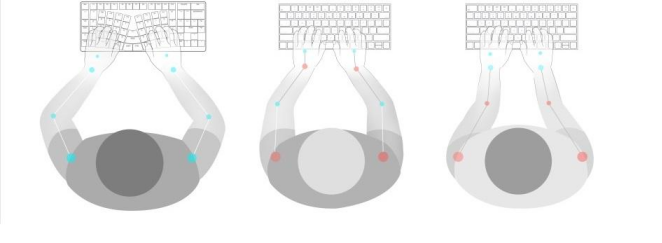
Ergonomic vs. Mechanical Keyboards
What's the Difference Between Ergonomic and Mechanical Keyboards
What is an ergonomic keyboard?
An ergonomic keyboard is a computer keyboard designed with ergonomic considerations to minimize muscle strain, fatigue, and other problems. Ergonomic keyboards for two-handed typists are typically constructed in a V shape, allowing the hands to rest at a more natural angle.
Generally, there are four types of ergonomic keyboards that provide different ergonomic considerations for different kinds of users. The most common type is the split keyboard which has keys that are separated into two to three groups. The others are the contoured keyboards, handheld keyboards and angled split keyboards.
1. Reduced risk of RSI and Carpal tunnel syndrome
People who type a lot using traditional keyboards, often end up with sore wrists (or shoulder joints) throughout their work day. This is an early warning sign of RSI. Because traditional keyboards don't allow your fingers and shoulders to stretch naturally, you suffer a lot of stress on your joints (or the shoulders that don't move for long periods of time) when you type, and these joint pains can become more and more problematic over the long term.
In this case, ergonomic keyboards are very helpful to reduce the risk of this injury. Ergonomic keyboards use a layout designed to more comfortably align to your body's natural angles. This encourages better typing posture and more comfort.
2. Increased Comfort
By alleviating the strain that users feel while typing, ergonomic keyboards are able to reduce typing fatigue. Typing fatigue is one of the main causes of pain and can build up, leading to more severe injuries. Many ergonomic keyboard users report being less tired at the end of their workday, because they don't need to deal with the mental burden of sore wrists and fingers.
3. Proper typing posture
As you can see from the picture below, if your keyboard positions your hands incorrectly, it's easy to type in the wrong position (slouched over, bent wrists, unextended arms). In the long run this poor posture can easily lead to more severe injuries. We have been taught to maintain the correct sitting posture since childhood, your typing posture is just as important.
4. Increased Typing Speed
After typing for a long time, our fingers and wrists will begin to feel sore, and it will be necessary to take a break. If we fail to take a break when needed, our typing speed will noticeably decrease. Ergonomic keyboards reduce finger travel, making it possible to type for longer without feeling fatigued (though it is still recommended to take occasional breaks).
5. Increased productivity
To sum up, if you are more comfortable typing and your typing speed is improved, your productivity will certainly be greatly improved.However, even if you have to work long hours in front of the computer, you should pay attention to rest.Ergonomic keyboards can only help you reduce stress to a certain extent, but they can't completely replace medication to help you treat illness.
1. There is a learning curve to the new layout
A new keyboard layout requires some time to retrain your muscle memory. Split ergonomic keyboards are notorious for their steep learning curve, while more compact ergonomic keyboards like X-Bows require a shorter adjustment period. Most X-Bows users report getting used to their new layout in 3-7 days. After a few weeks, many X-Bows report that their overall typing speed has increased 10-20%.
2. The price is higher than a regular keyboard
Because most ergonomic keyboards are custom designed (not using generic factory tooling), the manufacturing costs are higher. The main reason that most of giant keyboard companies persist in making non-ergonomic layouts is that it allows them to keep their costs down and make more money.
3. Not good for some gamers
The key alignment of some ergonomic keyboards is different from that of standard keyboards. The WASD keys are in a different alignment and that can require an adjustment for gamers. Some of the high-end ergonomic keyboards fix this issue by making their keyboards remappable.
What is a mechanical keyboard?
Mechanical keyboards are computer keyboards that have switches under each key, rather than the rubber membranes used in most common keyboards. Physical switches give mechanical keyboards a less "mushy" feel — every keypress can be clearly felt, making them perfect for precise and accurate typing.
Mechanical keyboard benefits
1. Full NKRO
NKRO stands for "N-Key Rollover". This basically means that a user can press any number of keys simultaneously without data being lost. This feature is common on most mechanical keyboards. Membrane keyboards will typically lose data if 3 or more keys are pressed at the same time. This feature is valuable for gamers and really fast typists.
2. Tactile differences
The design of the mechanical keyboard is different from the ordinary keyboard. Mechanical keyboard users like the feedback that is given by mechanical switches. It's commonly said that with a mechanical keyboard you can feel each key press and thus, type more accurately. Mechanical keyboard switches come in different types that determine the feel and noise level of each key stroke.
3. Service life
Mechanical keyboards are typically made from higher quality materials than non-mechanical keyboards. Most popular mechanical switches are rated to last 50 million key presses or more. On the other hand, most membrane keyboards have an estimated lifespan of 8-30 million keystrokes.
4. Reaction speed
Reaction speed is the biggest difference between mechanical keyboards and membrane keyboards. Mechanical keyboards allow for faster reaction times while gaming, and a more acute sense of when a key is pressed - leading to fewer typing mistakes.
Mechanical keyboard weaknesses
Mechanical keyboards are still considerably more expensive than most membrane keyboards. In the past, a single company owned the patent to produce mechanical switches and that kept prices artificially high. With more and more companies releasing their own switches, mechanical keyboards have become more popular and are available at a wider range of price points.
Ergonomic mechanical keyboards
You can get an ergonomic keyboard, you can get a mechanical keyboard, but why not get the benefits of both in one keyboard? There is a growing demand for ergonomic mechanical keyboards - keyboards that combine an ergonomic layout with the enjoyable typing feedback of mechanical keyboards.
This is still a growing niche and some of the offerings can be quite expensive (over $300!). Some newer options in the $100-$150 range have recently been gaining traction.
Top 3 Ergonomic Mechanical keyboards
X-Bows Lite
* Ergonomic design. The four keys in the middle of the keyboard work to reduce finger travel.
* Uses QMK open-source firmware for excellent customization
* Full RGB backlighting with shine-through keycaps.
* Relatively faster learning curve than other ergonomic mechanical keyboards.
* Uses popular Gateron mechanical key switches.
Ergonomic Mechanical Keyboards Are The Future
Ergonomic mechanical keyboards are ideal for nearly all desk workers. Over 1 million people each year are diagnosed with repetitive strain injury (RSI) because they haven't protected their health while typing. The design of traditional keyboards is not suitable for all day use, so expect that more people will begin to use ergonomic mechanical keyboards in the future.

















